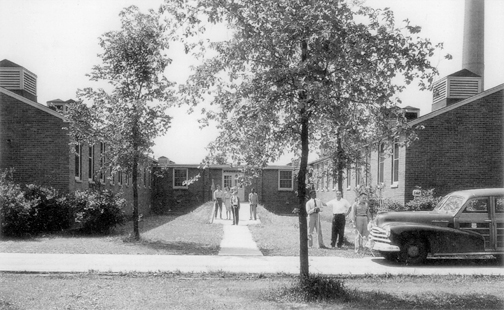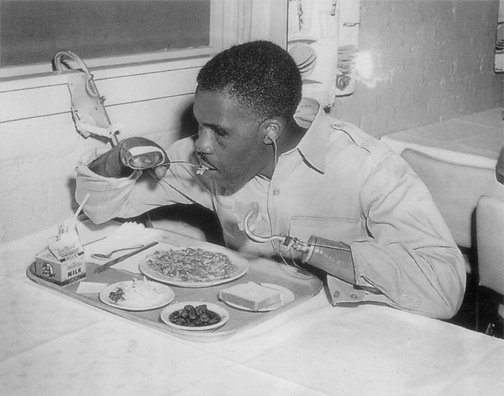Rehabilitation and Prosthetic Services
BRS History: Hines BRC Program
Mr. Bledsoe's next action was to appoint a Chief for the new Blind Rehabilitation Center. Russell C. Williams, a blinded World War II Veteran, was selected as the first Chief of the Hines Blind Rehabilitation Center. Mr. Williams had been serving as a counselor for blinded soldiers at Valley Forge, and had also participated in both blind rehabilitation training programs at Valley Forge and Avon Old Farms. Bledsoe described Williams as follows:
"If Russ had not been the person he was, there would have been no Federal program for the War Blinded worthy of the name after 1949. Seldom has the likeability of a man so kindly and astutely devoted itself to wheedling fellow human beings away from foolishness of various kinds. A sort of moral wizardry with which he is endowed was to be the fundamental stuff out of which the Hines program was to be made."
 Kay Gruber was then enlisted as a consultant to assist Williams in selecting and training instructors for the proposed nine-bed unit. Harry Sparr, from the Industrial Home for the Blind in Brooklyn, NY, was the second consultant brought in to develop the industrial aspects of the program. The third consultant, Richard Hoover from the Valley Forge staff, was brought in to help train the newly selected "Orientors" in his cane techniques.
Kay Gruber was then enlisted as a consultant to assist Williams in selecting and training instructors for the proposed nine-bed unit. Harry Sparr, from the Industrial Home for the Blind in Brooklyn, NY, was the second consultant brought in to develop the industrial aspects of the program. The third consultant, Richard Hoover from the Valley Forge staff, was brought in to help train the newly selected "Orientors" in his cane techniques.
Bledsoe and Williams were convinced that the corrective therapists at Hines seemed to be the most suitable for the "Orientor" role due to their physical education background and their knowledge of kinesiology, anatomy, posture and gait. Besides, they had experience in working with other disabled war veterans and appeared to meet the basic qualifications of "common sense and durability". Williams would go on to note that he looked for: "sincere, healthy minded, emotionally balanced persons, with varied interests and sufficient security to respect their fellow workmen and the patients with whom they would come in contact". He wanted staff members who communicated with ease, were loyal to their job, and committed. Those chosen included Alfred Dee Corbett, Edward Mees, Joseph Romanko, Stanley Suterko, and Edward (Bud) Thuis.
Manual Skills would also be a component of the Hines program. A. Stafford (Charlie) Chiles, a Manual Skills teacher from the Maryland School for the Blind, was hired to set up the manual skills component of the program. Braille also constituted an important part of the program and, interestingly, Williams decided to teach Braille besides performing his administrative duties "in order that it be identified with him and that the environment be favorable toward its use".
Bledsoe and Williams would combine to provide most of the staff training, and both agreed that no specific part of the Hines program should be given greater status over any other. Travel training would incorporate the "orientation" taught at Valley Forge and the "mobility" taught at Avon. The training would be called “Orientation and Mobility”. Russell Williams would be the primary teacher of “Orientation and Mobility” based on the adaptive techniques he had developed since his training at both Avon and Valley Forge; Richard Hoover would be brought in as a consultant to review this portion of the program.
By the time he arrived at Hines, Williams had already started using a systematic, scanning cane technique as he came to realize that the security of knowing what was on the ground allowed him to walk upright in a graceful and sophisticated manner. Moreover, by relying on the cane to provide tactile feedback, Williams was also able to easily utilize his other senses, especially hearing. As a result, Williams became very adept at using reflected sound to help with orientation and object location during his travels – a skill that would be especially important while crossing busy streets and locating bus stops. In addition, Williams also developed adaptive techniques while negotiating stairs and traveling in crowded situations.
The orientation and mobility staff at Hines enhanced their teaching methodology by observing Williams travel in different situations, after which they would wear blindfolds and perfect their techniques until a standard procedure was developed. It would be a systematic approach that started with specific actions characterized by right angle relationships involving "squaring off" to objects within the setting. Ultimately, the blinded veteran became confident enough to move smoothly and naturally through his environment without having to use such a specific procedure. In time, the Orientors became so confident in their knowledge base that they had no qualms about advising Williams when he was using his cane poorly. This constructive criticism helped Williams realize that other blinded veteran’s would also get "rusty or careless" and might need refresher training at some point.
In due course, the Hines orientation and mobility staff would develop a system for measuring a cane to match a person’s stride. They also devised the technique of using traffic sounds for direction taking purposes, as well as knowing when to cross a street. The idea of projecting a straight line of travel was also developed at Hines and taught as a learned skill in a large training room before the veteran would be allowed to travel outdoors. The rapidly advancing travel system being developed by this new group of "Orientors," which featured a cane scanning method identified as the "touch technique," left Hoover increasingly amazed each time he returned to Hines.
It is also notable that the Hines staff began using a blindfold on Veterans with residual vision. In Williams’ words:
"It was never done in anticipation of the loss of additional vision. A lot of people never understood that. Rather, we were interested in getting a person to depend more on hearing, kinesthetic clues, and touch. More importantly, we were interested in getting a person to trust these other senses. It was one thing to use another sense but it was something entirely different to trust it. We believed that the blindfold would help the veterans with low vision develop this trust. Sometimes, when the blindfold was used, the veteran thought that his sight had improved after it was taken off. We never thought that it actually had, but perhaps it helped people separate where actual information was coming from. Adding the information received from hearing to the information received from sight helped some patients sort out one from the other."
 The Hines staff decided that every veteran would be required to participate in each component of the training program. It was their belief that doing so would serve to help those patients, who were struggling in the more difficult classes, to maintain an interest in the overall program until they got past the troublesome stages. For example, Williams noted that the achievements gained in manual skills were especially helpful, as the successes gained from making simple projects in this area frequently kept a person interested in the program at large until he was able to feel successful in classes such as Braille and mobility.
The Hines staff decided that every veteran would be required to participate in each component of the training program. It was their belief that doing so would serve to help those patients, who were struggling in the more difficult classes, to maintain an interest in the overall program until they got past the troublesome stages. For example, Williams noted that the achievements gained in manual skills were especially helpful, as the successes gained from making simple projects in this area frequently kept a person interested in the program at large until he was able to feel successful in classes such as Braille and mobility.
The Hines staff also believed in the concept of using a proper sequence of training lessons in order to establish a success pattern - and they would make this the fundamental basis of their program. They felt that success needed to be achieved quickly and this could only be realized by using the approach of starting small and building up successful experiences. The Hines knew that the activities being taught would only hold a person’s interest if their usefulness in later life were obvious. As such, the underlying theme was that the Blind Rehabilitation Center would: teach blinded veterans the techniques for study through Braille and communication skills; teach the general concepts of work by taking an organized approach to various tasks; have the patient understand the concept of substitutions and modifications for the lack of eyesight; and use practical methods to gather and dispense information.
A missing element from the initial curriculum was typing and writing, but Genevieve Miller was hired two months after the Hines Blind Rehabilitation Center opened to teach these two critical skills. Miller would later assume the responsibility of teaching Braille during the Korean War Conflict. The final staff member added was the program secretary, Loretta Goergen. The Hines Blind Rehabilitation Center admitted its' first patient, Naron Ferguson, on July 4, 1948; one year after the closing of the Avon program.



















